While enjoying a romantic evening at the Outermost Inn in Aquinnah not long ago, I gazed down upon the expansive lawn. The sun was setting as deer pranced among the trees into an open field. The serene scene unfolded as we toasted with friends to this lovely summer night. But as a red-tailed hawk flew over, I closed my eyes and memories rushed back. Like the opening from Star Wars, long ago and far away…when Aquinnah was Gay Head. When Spazzini – a.k.a. Craig “Spa” Tharpe – did a handstand on a skateboard down Abel’s Hill. When the narrow path led you to the scantily clad at Zack’s. And always the beautiful cliffs.
When my eyes and ears reopened, it was once again the fall of 1979. In place of the bucolic meadow below was a smoking cacophony of the roaring engines of cars racing and banging into each other, while at the same time always avoiding that outrageously large rock right in the middle of a loosely laid out figure-eight course. In place of the demure Outermost Inn diners sipping champagne and slurping oysters, screaming spectators followed the collisions, the wreckage, the turned-over cars as a bunch of locals were soon to decide who would be king of the road.
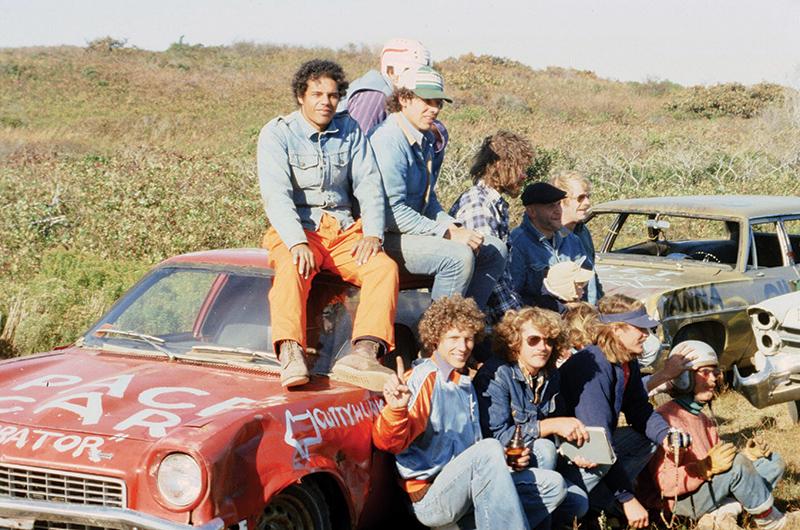
The now legendary demolition derbies, a.k.a. the Crunches, took place around Columbus Day weekend of 1979, 1980, 1981, and 1982 with Vineyard Sound providing a gorgeous backdrop. Four thrilling years they were, and the weather always seemed to cooperate. Crowds grew every year. No need for advertising. In those days, everyone just knew about the special events. Just as everyone knew about the Thanksgiving Day horse races at John Hall’s field and the Whippoorwill Yacht & Rocket Club model sailboat races off Lobsterville. Everyone just knew. Hanging off AT’s fence at the Ag Fair. Any summer night at the Bulkhead Lounge in Oak Bluffs. Thursday nights at the Square Rigger. Friday nights at the Sea View with Loretta and Johnny. Back door at the Ritz. Everyone just knew.
The creation of the Crunch stirs misty memories about its fabled origin. I figure I’ll start at the top. Sadly, Carl Widdiss, who concocted the scheme, died in 2014. A respected man and very well liked in th community, Widdiss had served as an Aquinnah selectman and was a member of the town’s volunteer fire department. In fact, all proceeds from the 1982 Crunch went to the fire department. He owned Widdiss Recovery, an auto towing and repair company. He was truly one of the good guys.
Hugh Taylor and his wife, Jeanne, hosted the four years of racing. Long before it became the Outermost Inn, it was their family home, simply known as Hugh & Jeanne’s. Taylor and I thought about calling the racing track there the Gay Head Motor Speedway – a takeoff on the old Seekonk Speedway, a funky Massachusetts track mostly known for its television and radio spots with the announcer screaming “SUNDAY” at the top of his lungs.
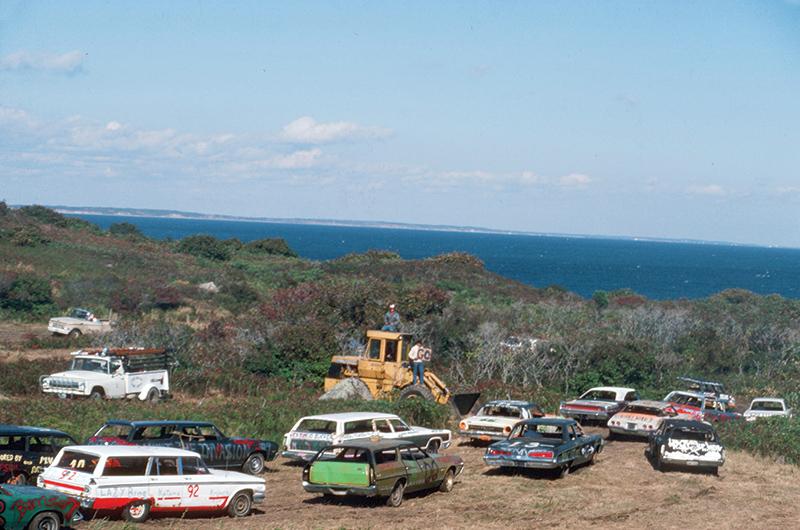
“The fact is, as my shaky memory recalls, it was Carl’s idea,” Taylor said of the start of the demolition derbies. “The way I’ve been telling it for years is that when the commonwealth decided they wanted to double down on car inspections – previously they hadn’t been very aggressive, and particularly lax on the Islands – they decided that more scrutiny would result in more condemned cars and more people buying new cars, thus increasing the excise taxes collected in these places where nobody was driving a car worth a nickel.
“Anyway, Carl, a man at the forefront of fixing these wrecks, asked the question: ‘What’s gonna happen to all these perfectly good cars when they don’t meet the new inspection standards?’
“Well, between us, we came up with the idea for a demo derby to usher these old warhorses along to the happy squishing grounds. That was that. We passed the word along through the telegraph, the bars, liquor stores, and garages. No one believed it was real, so we only had about nine, maybe thirteen cars in the first one. You know the rest. There were pissed people who claimed they hadn’t heard about it, but the next races were, as you know, well populated and well attended.”
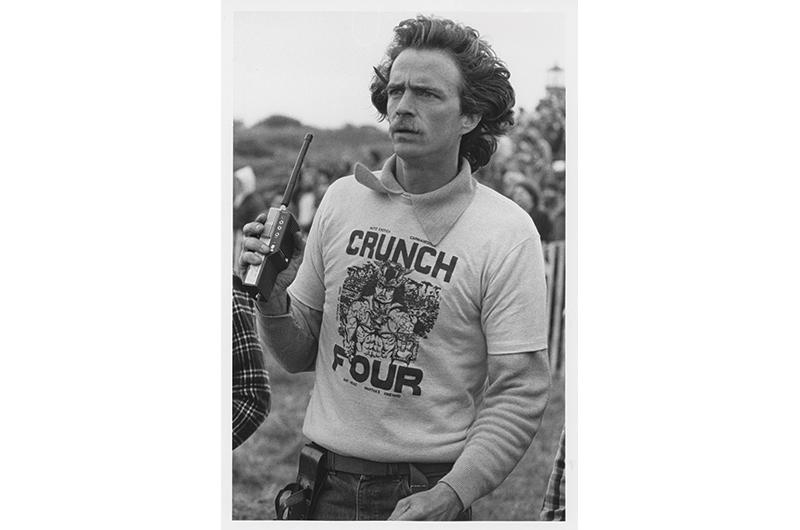
People in the know did indeed find out. And if you knew the right people, which is to say if you knew Bill “Trader” Shay, you could find an ancient set of wheels that could be rescued for a derby run. Shay had a lot full of old cars tucked in at the airport. Seems he also had a racetrack tucked in there too. He had the offer you could not refuse. Fifty dollars for any car on the lot. Push it. Pull it. Tow it. Fifty bucks. No refunds. To this day people still wonder how unregistered, uninsured, unsafe cars ever got up-Island without attracting the attention of the law. According to Island Tire & Auto Service owner Alan Wilson, whose 1966 Rambler found its way to the track, “everything went well until the time Chief [Kenny] Belain handed us a $50 ticket. But we were in the race.”
I, too, had daredevil racing dreams. As the proud owner of a powerful 1963 Oldsmobile, I couldn’t wait to customize my ride. Then I ran into Widdiss andhe delivered the devastating news:
“Kenny, you are the MC.”
“No way, I have a car.”
“You are the MC!”
One look from Widdiss was all it took. I was the MC. As it turned out, thanks to our talented Island builders, we had topflight staging, and I had the best seat in the house four years running.
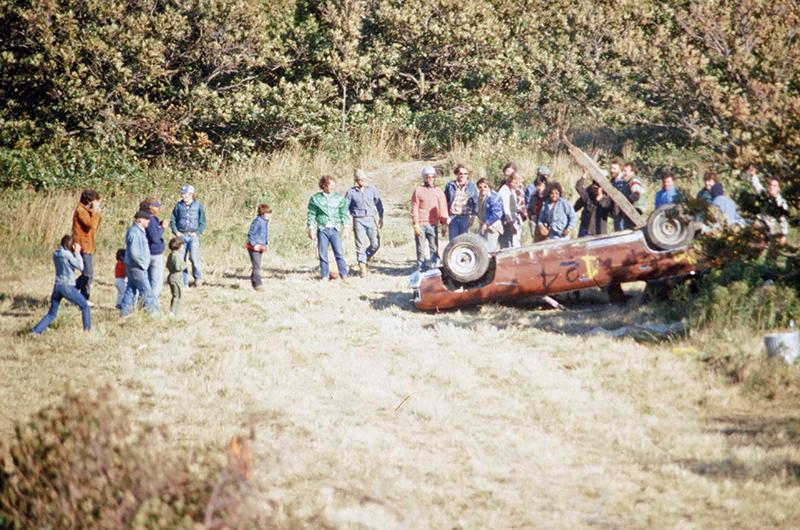
Taylor won the inaugural Crunch in 1979. News of his victory spread quickly, even as far as Nantucket, which, as it turned out, had been holding a demolition derby of its own for a number of years. Jimmy Buffett, vacationing on Nantucket, heard about the one in Gay Head and invited Taylor and Widdiss over. They went to our sister island and found a wreck. Buffett sponsored the aptly named Landshark, fins and all. Widdiss fixed it up and Taylor drove it to victory. In the interest of common decency and good taste, I was asked to keep details of their Nantucket post-race celebration private.
The next year, Taylor looked for another win. However, despite the chains on his tires for better traction, he knew he was a marked man. “I was targeted for my past successes and my cheating ways and was one of the first cars crunched out of my heat,” Taylor said.
The 1980 Crunch also featured the debut of Bill “Norton” Russell. Although he entered a different car three years in a row, his favorite was a mid-1950s Chevy, a beauty he called the Percodan Princess. He was in contention when he made the decision to save his radiator and complete the final lap racing backward over the finish line.
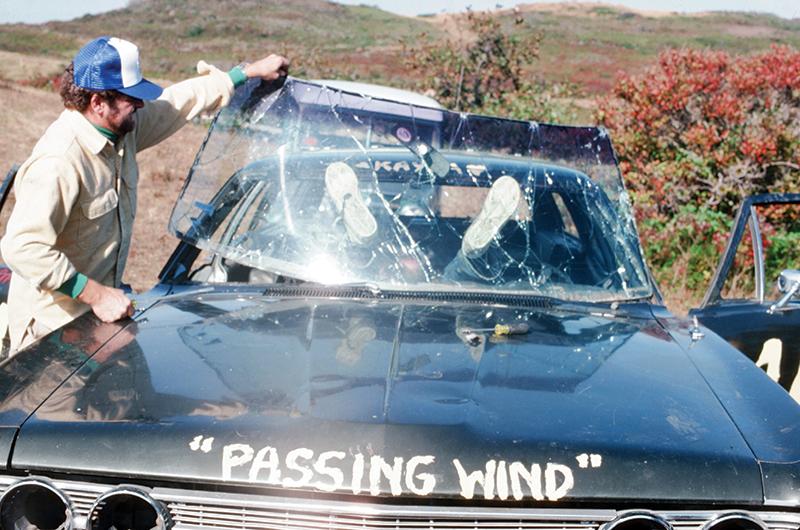
The real highlight of year two, however, was the one and only Golden Goose. Owner BJ Dugan bequeathed the ancient Ford Torino to her son Glenn Andrews. Andrews confidentially let me know that his mother had no idea that her car was entered into the Crunch. Selected to drive this vehicular behemoth was John Early, who was simply magnificent behind the wheel. The Golden Goose, with its double zero (00) moniker on the hood and an artificial golden goose perched atop the roof, may have been the only car ever to race in more than one derby – Early and the Golden Goose won Crunch III the following year and competed in 1982, too. At least according to some people’s memories.
Just naming the cars took imagination: Big Daddy, Hats off to Larry, Bonzai, Toxic Shock, Blue Cheer the Swedish Angel, Golden Goose, Barrister T, The Graves Machine, Mom’s Worry, Big B, Almondine Queen, Mallennyium Falcon, Controlled Substance, Adios Amigo, White Trash, Captain Crunch, Ol Smokey, Katama Krunch, Death to the Pope, Percodan Princess. Of course, some names were self-explanatory: MV Drywall, The Square Rigger, Vineyard Decorators Wood Power.
Pre-race in the pits, the real work began. Windows were knocked out, mirrors removed, headlights pulled from their sockets. Then the artwork started. Call it graffiti, call it painting, such talent was on display. All to be crushed and crunched that afternoon.
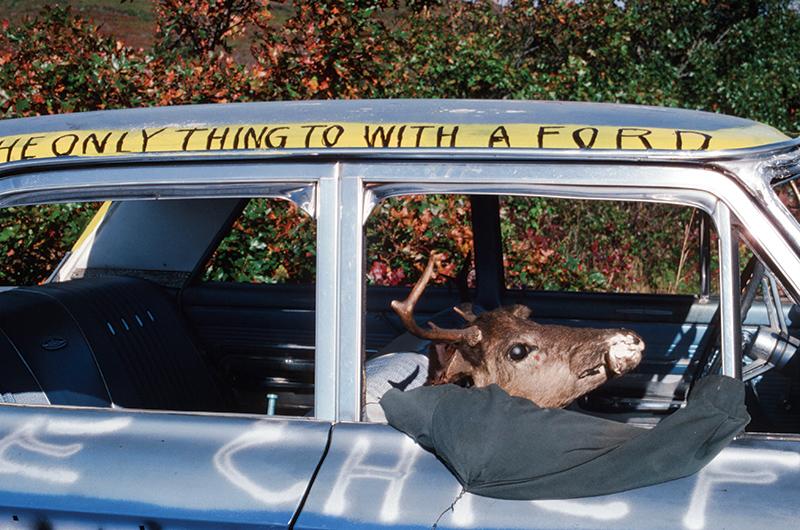
Lenny Butler, owner and driver of Blue Cheer the Swedish Angel, lovingly remembered assembling his unique Volvo for the derby. “Warren Meade could fix any Volvo,” he said. “My wife Mallory’s Volvo had sat quietly in the woods for two years. Gee, it didn’t start. What a surprise. Warren and I went to the airport, got some Aviation Fuel, a.k.a. ‘Av Gas,’ installed copper-tip hot plugs. It started, and despite using two gallons of oil to one gallon of gas, we drove it home primed for the derby. Belching blue smoke rings, we were doing quite well in the race until someone rammed us into the big rock in the middle.”
Butler was no one-hit wonder. He also was the guiding light in the following year behind the wheel of his genuine 1967 Ford Falcon, dubbed the Mallennyium Falcon.
In the course of reporting this story, some drivers came out of the woodwork with memories – some hazy, some even hazier. Kenny Belain Jr., owner of Mid-Island Auto and a three-time Crunch competitor, was the only driver in the race that had wildlife riding shotgun. According to his wife, Ro, the deer once graced the walls of the garage before its move to the front passenger seat of the 1963 Ford Galaxie. This was no deer in the headlights to be trifled with. The car, Captain Crunch, enjoyed another unique feature: if you stepped on the dimmer switch, the window washers went on. “I was able to keep both hands on the wheel,” Belain Jr. explained. He was pleased with his driving until he met the legendary rock in the middle. One split lip and hospital visit later, he realized he did not have a demolition deductible on his insurance policy. No report on what happened to the deer.

Scott McDowell, who drove his Ford Country Squire station wagon, Mom’s Worry, was consistent in his recollections: “I have no idea where I finished.” However, race insiders reported that McDowell and Belain Jr. dueled to the finish line, but not to the winner’s circle.
Tharpe, who previously arrived by sail from the Caribbean to the Vineyard at the tender age of seventeen, entered a vintage Buick, the Almondine Queen. Two laps later, he went from driver to spectator as the Almondine Queen performed a Marie Antoinette: the engine blew and the head gasket was lopped off.
Bob Gosselin drove an Island Tire special. “I drove a few laps, got knocked out of the race, got a ride to the airport, took the plane to New Bedford, got picked up by friends, drove to New York, went to Shea Stadium, saw The Who,” he recalled. “It was all a blur.”
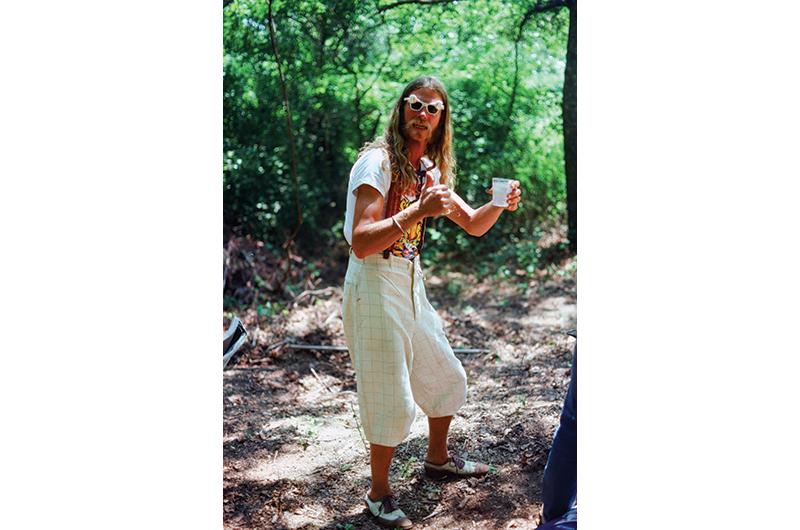
Oozing confidence, Doug Hoehn entered his Plymouth Valiant, a.k.a. Valiant, painted from hood to trunk with a mermaid. According to Hoehn, rumor had it that his driver, Matt Viaggio, had raced against the legendary Joie Chitwood at the famous Islip Speedway. The Valiant bottomed out after two laps and Viaggio didn’t quit his day job.
In year one, Andre Bonnell recalled entering the U812, a Chevy that quickly went to Crunch heaven. In year two, not to be denied, he, along with James Paquette, found a seemingly abandoned Volvo in Oak Bluffs. The two good Samaritans decided to beautify the town by taking the car to the derby. As Bonnell remembered it, “While I was registering the car, the phone rang. The call was for me. It was the owner of the car. Seems that we had towed it right past his house. Uh oh! Turned out that I knew him, and he was thrilled when he found out the car was going to be in the derby. He just wanted to join the team to be part of the pit crew. As it turned out, the drive from town to the derby lasted longer than the car’s performance in the race.”
As for me, I had the best seat in the house: perched atop solid staging with a superb sound system and a great view. So began four years of calling the races, yakking, promoting, selling, announcing, laughing, and joking. No official attendance records exist to this day, but believe me, it seemed the whole Island was there.
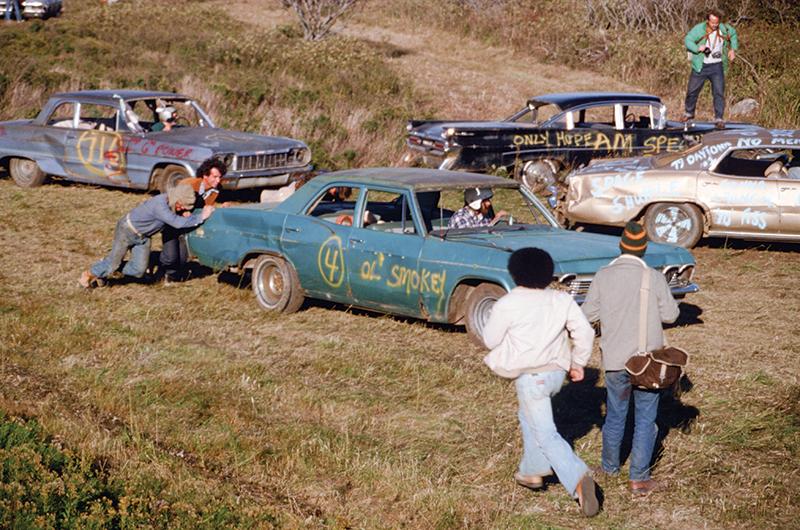
The crowds roared at every crunch, winced at every collision, cheered at near misses and close calls. The rock in the center provided a true test of driving skill. Car met rock. Rock met car. Rock crunched car. Like miniature geysers, smoking radiators signaled the slow demise of these metal hulks on wheels. Real drivers will tell you the radiator is the Achilles heel of any demolition derby car. Cars slammed into reverse to avoid head-on collisions.
Donald Muckerheide and his crew came up with a novel solution to protect the radiator from Greek tragedy. He removed the back seat of his 1972 Impala, put in a second radiator, and ran a hose from the engine. It was a great idea. His car, the Psycho Killer, was cruising along with James “Jaimer” Paul at the wheel. If the forward radiator was crunched and overheated, he would simply hit the custom-made toggle switch to activate the second radiator.
“Everything went according to plan,” Muckerheide said with a sigh. “Unfortunately, Paul forgot to hit the toggle switch and the Impala went up in smoke.”
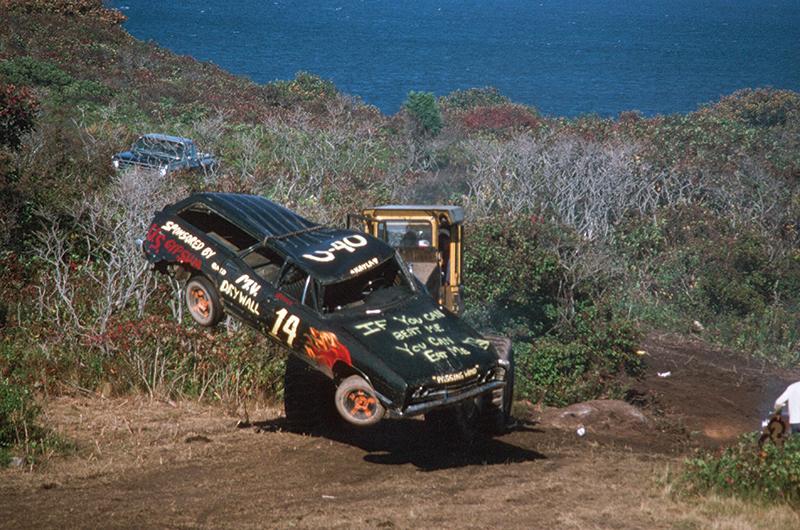
Albie Robinson, an avid Dukes of Hazzard fan driving his Orange #10, the aptly named General sLeeze, discovered that three lanes of cars trying to get through two lanes and one rock was a challenge. “Beach tires and buckets of sand in the trunk gave me great traction. I led in one heat and the General sLeeze survived two derbies.”
Of course, safety measures were of paramount importance. In any derby, cars are demolished and must be removed from the track. Enter Billy Dias Jr. and his legendary bucket loader. Dias was a pro. Quiet and friendly, he handled his job with care and aplomb. After all, a demolished vehicle needed to be removed in a timely fashion.
Once cleared from the track, everyone on the Vineyard knew that when it was time for a wreck to go to vehicle heaven, call Johnny Leite. Now the owner of JWL Transport, a landmark Oak Bluffs business, Leite helped many people over the years. He crunched the leftovers, put them on the flatbed truck, and hauled them off-Island.
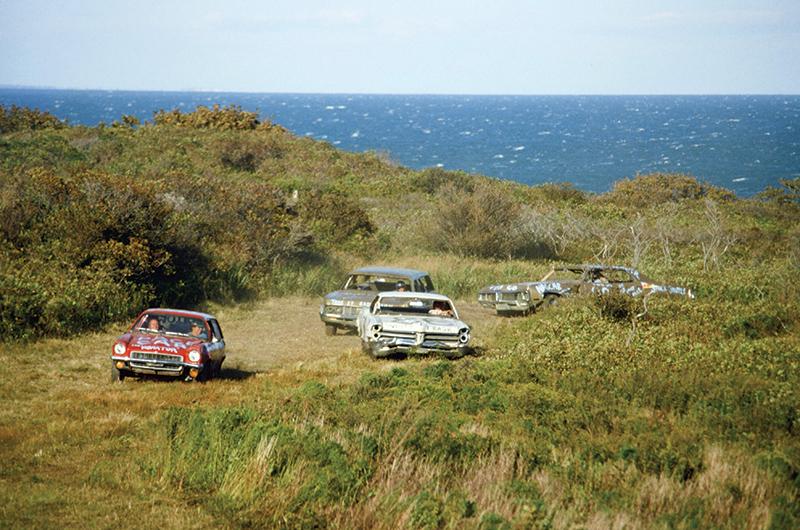
The Crunch brought out other enterprising entrepreneurs. At the top of the list was Donald Widdiss, whose Crunch III and Crunch IV shirts are legendary and a must-have for any serious collector of Vineyard memorabilia. These days, Donald is a master craftsman in the art of wampum, but nearly fifty years ago, after a brief stint in college, he found his calling in T-shirt design. His first Vineyard effort was the now very hard-to-find “Drinkin’ likker” shirt made for Jim’s Package Store.
Inspiration for the Crunch III shirt came when he approached Taylor and his brother Carl Widdiss, who issued the stern directive: “Do whatever you want!” And so, the Crunch III shirt, in all its glory, was made. The Crunch IV shirt, a.k.a. Carmageddon, is a classic display of the vivid Donald imagination.
The final Crunch took place in 1982, when some forty-plus cars competed. With so many cars, there now had to be qualifying heats. The top two cars from each heat advanced to the finals. But truth be told, if your car survived the heat, you could enter the finals. The judges were not exactly sticklers with the rules. In fact, we’re still looking for the supposed rules.
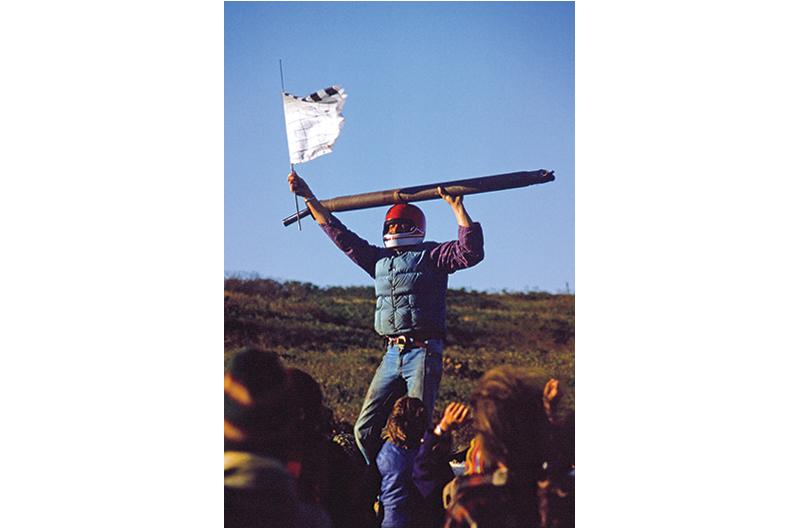
Sailor extraordinaire Billy Bones, whose dealings with the United States Coast Guard were not always, shall we say, copacetic, found his Ford station wagon, Controlled Substance, lined up next to the Coast Guard’s entry. Controlled Substance featured a number of bales of what was believed to be hay (hmmm) piled on top of the luggage rack. Fortunately, the only items busted that day were the bales that fell off. (I contacted the Coast Guard for this story, but, alas, everyone I spoke with had not yet been born during the Crunch years. Oh well.)
With the heats done, it was time for the 1982 finals. And oh, what a final it was. No one there will forget the crash. In four years of racing, the Crunch had only two female drivers, one of which was Jackie Clason. Confident in her ability to compete, she recounted: “As an experienced Vineyard cab driver, I was always looking for an opening when I was driving on the clock.”
Her strategy worked well. Behind the wheel of her Chevy Vega, Joy to Destroy, she maneuvered around the carnage and wreckage – at least until a sudden sideswipe toppled her car over on its side. Immediately, people ran to the rescue and a band of quick thinkers righted the car. Clason crawled through the opening, climbed to the top of the car, and waved to the crowd. She was fine – and had solidified her title as a Crunch legend.
Post-collision, it was getting down to the nitty gritty of the race. Enter Doug Hakey, driving his black 1970 Pontiac, the Night Stalker, in his inaugural appearance. He managed to avoid one crunch after another and just kept on going until he won the whole darn thing. “One race, one win, and I retired undefeated,” Hakey was happy to proclaim. “After the post-race celebration, I even drove the car home.”
Admittedly, times were different then. Among so many other factors, who could imagine today people getting behind the wheel of a car with no lights and no windows and driving late at night just to get to the Crunch starting line?
“We all thought we were invincible,” said Taylor. But as the event grew, safety, insurance, and liability started dragging us into the world of adulthood.
In conversations now, Taylor gives much credit to Widdiss. We all do. But, of course, he didn’t do it alone. He and Taylor plus a bunch of locals put this event together and managed to have four fun-filled years. Forty years later, the wistful memories live on. We miss those who are no longer with us. And we remember the warm memories and great times. I know I do, even if I was behind the microphone instead of the wheel.
Additional Photos from the Crunch Years
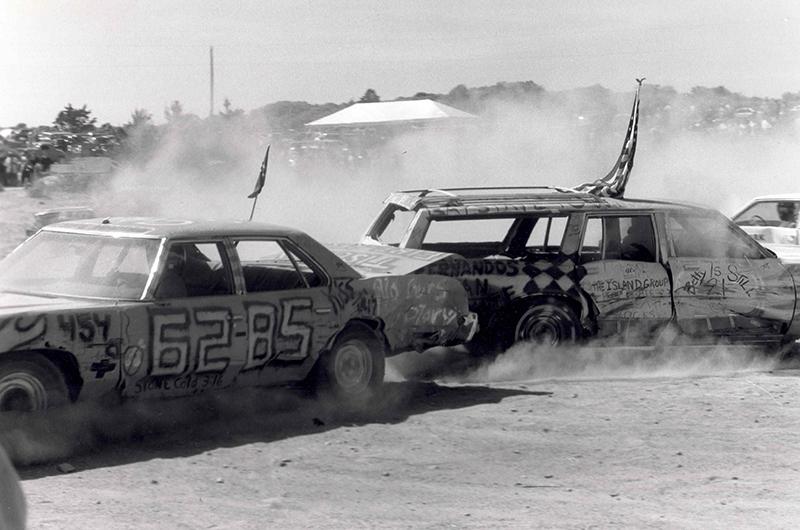
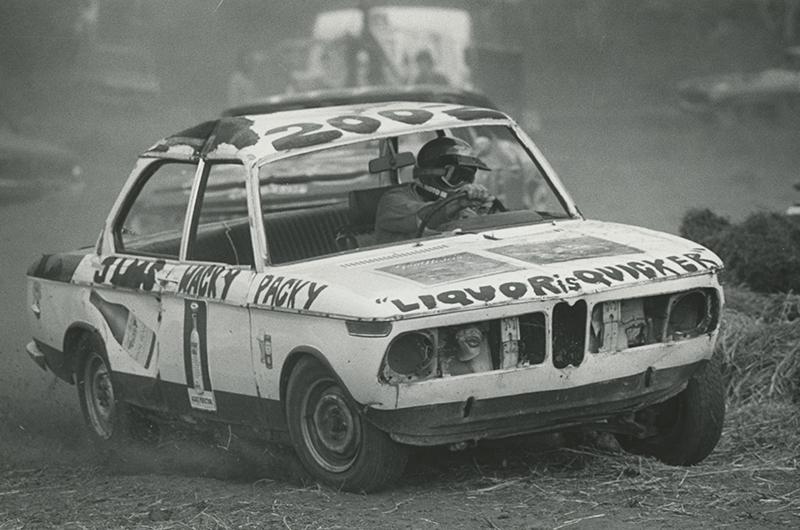



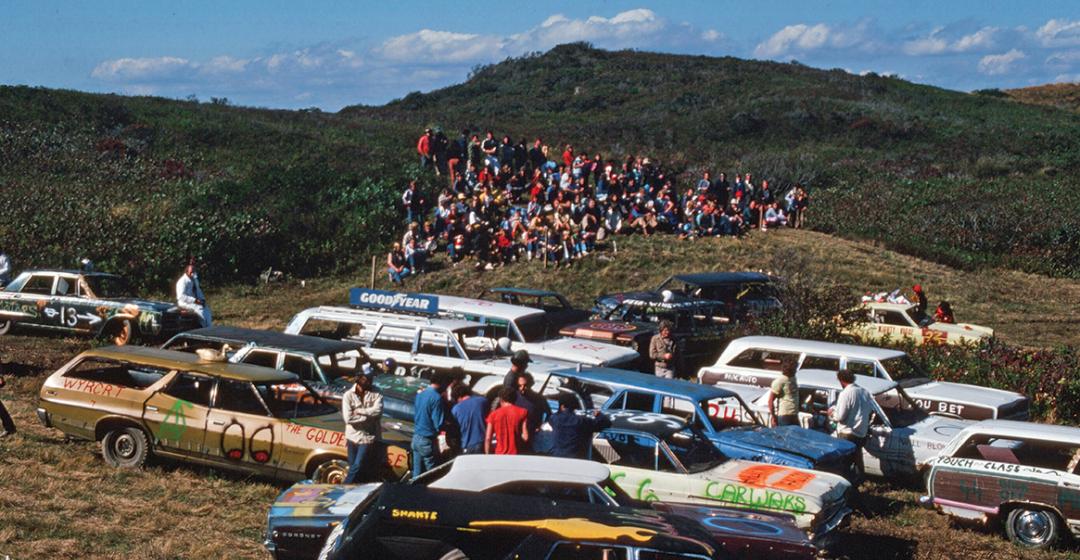


 3 comments
3 comments
Comments (3)